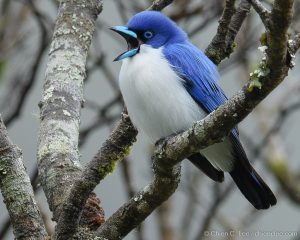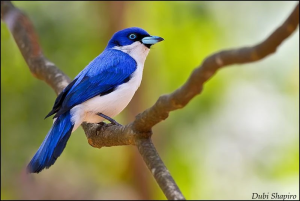Meet Blue Vanga: a bird with a beautiful plumage that blends blue and white in harmony
With its stunning blue and white plumage, the Blue vanga (Cyanolanius madagascarinus) is a bird species that captures the attention of bird enthusiasts and nature lovers alike. This beautiful avian creature belongs to the Vangidae family and is known for its stylish appearance and graceful demeanor. Let us delve into the fascinating world of the Blue vanga and explore its unique characteristics.

The male Blue vanga boasts a vibrant blue coloration that covers its body. It features a black line extending from the eye to the base of the bill, creating an eye-catching contrast. The pale blue eye-ring and black-tipped wing edges add to its overall elegance. Its chest and belly exhibit a striking shade of white, complementing the blue bill and grey legs.

In contrast, the female Blue vanga exhibits a slightly more subdued appearance. Her overall coloration tends to be duller, with an off-white chest and belly, tinged with pale orange. Her wings also display a subtle hint of green, adding a touch of uniqueness to her appearance.

The Blue vanga is primarily found on the island of Madagascar, alongside other members of the Vangas species. However, it can also be spotted on Mohéli island in the Comoros. These birds thrive in diverse habitats, ranging from forests to woodlands, where they can forage and nest comfortably

Blue vangas are known to forage in the middle and upper levels of trees, where they hunt for insects, earthworms, millipedes, lizards, and amphibians. While their diet primarily consists of animal prey, it is believed that they also consume fruits when available, showcasing their adaptability.

The breeding season for Blue vangas typically occurs between October and December. During this time, they construct cup-shaped nests approximately 12 meters above the ground, carefully selecting forked branches or slender twigs for support. The nests are made from twigs and a soft, down-like material. Within these nests, the female lays pale blue to green eggs, adorned with red to brown speckles.
